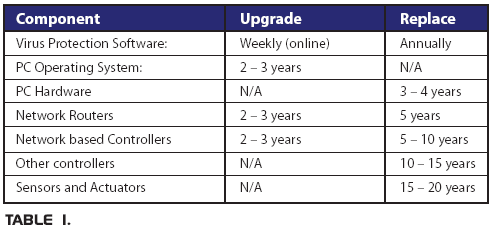February 2006
![]()
AutomatedBuildings.com
[an error occurred while processing this directive]
(Click Message to Learn More)
February 2006 |
[an error occurred while processing this directive] |
|
What we need to keep in mind, however, is that the benefits of adding technology to buildings will far outweigh any of the risks. |
A Healthy Fear of Technology! Building Automation System
Ethernet Switch Selection A Return To Growth
Defining The Intelligent Building
Control Market |
Intelligent buildings require the use of technology, yet many consultants, contractors, and owners are concerned about the risks of introducing new technologies into buildings. They look at their every day interaction with technology and see computers that have become obsolete, unexplained crashes, unwanted hackers, viruses, and other risks. As prudent professionals, how can we not worry about applying technology which seems to change every day to a building where we expect core systems to last for 20 to 40 years?
|
|
|
|
|
|
|
|
|
|
|
|
|
|
|
|
|
|
|
|
|
[an error occurred while processing this directive] |
These are all justified concerns. In fact, a healthy fear of new technology is not a bad thing. What we need to keep in mind, however, is that the benefits of adding technology to buildings will far outweigh any of the risks. Benefits can include greater occupant comfort, improved operational efficiency, and lower expenses and energy utilization. What we must do is mitigate the risks. How do we do this? The best solution is to have a plan to manage technology in buildings. Table 1 shows an example of the elements of this plan.

TRAINING
When new systems are installed on a project, it is critical that the operations
staff be properly trained on how to operate and maintain them. Without proper
training, technology will be doomed to fail. Systems that involve technology
such as Web- enabled automation systems, enterprise management systems, and
workorder tracking systems may also require coordination and training for the IT
staff as well.
[an error occurred while processing this directive]
TESTING, MONITORING, AND
VALIDATION
Like any building system, those that are technology-based need to be
properly validated on installation and regularly tested and monitored. The test
and monitor for these systems, however, goes beyond making sure that the systems
operate as designed. Monitoring involves evaluating the network for hostile
traffic, doing regular checks for viruses, and other problems. The test plans
will typically be created in cooperation between the IT group and the facilities
group.
PLANNED UPGRADES
As technology evolves many of the software and hardware components
will become obsolete prior to the end of their usable lives. Upgrading these
systems can often provide improved performance, easier support, and improved
functionality and usability. It is best to plan for regular upgrades upfront.
Here is a rough guide on anticipated system upgrade or replacement. Using
technologies in building provides many benefits in lowered energy cost, and
reduced operating expenses. These benefits are well worth it, but the cost to
appropriately maintain and upgrade these systems has to be budgeted for
properly. Well designed technology that is implemented and supported properly in
buildings is invaluable.
About the Author
Paul Ehrlich is a well-known industry stakeholder and advocate of integrated and intelligent buildings. In 2004 he formed the Building Intelligence Group www.buildingintelligencegroup.com an independent consultancy, whose primary purpose is to help system suppliers, as well as building owners and managers, maneuver their operations through the vast changes prompted by enterprise building management. Paul is also a regular contributing Editor for AutomatedBuildings.com.
[an error occurred while processing this directive]
[Click Banner To Learn More]
[Home Page] [The Automator] [About] [Subscribe ] [Contact Us]